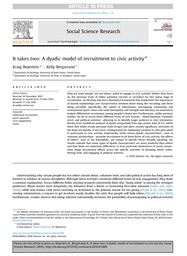
ATTENTION: The works hosted here are being migrated to a new repository that will consolidate resources, improve discoverability, and better show UTA's research impact on the global community. We will update authors as the migration progresses. Please see MavMatrix for more information.
Show simple item record
| dc.contributor.author | Beyerlein, Kraig | |
| dc.contributor.author | Bergstrand, Kelly | |
| dc.date.accessioned | 2017-11-21T00:50:03Z | |
| dc.date.available | 2017-11-21T00:50:03Z | |
| dc.date.issued | 2016-11 | |
| dc.identifier.citation | Published in Social Science Research 60: 163-180, 2016 | en_US |
| dc.identifier.uri | http://hdl.handle.net/10106/27075 | |
| dc.description.abstract | Why are some people, but not others, asked to engage in civic activity? Rather than focus on the personal traits of either potential recruits or recruiters for this initial stage of recruitment, we develop and test a theoretical framework that emphasizes the importance of shared relationships and characteristics between those doing the recruiting and those being recruited. Specifically, the nature of interactions, overlapping community and associational space, status and value homophily, and strength and intimacy are assessed to explain differential recruitment among people's closest ties. Furthermore, unlike previous studies, we do so across three different forms of civic activity - blood donation, volunteer work, and political activism - allowing us to identify larger patterns in civic solicitation. Results from multilevel analyses of dyads reorganized from ego-centric data of U.S. adults show that while certain personal traits of egos and alters remain significant, attributes of the dyad are equally, if not more, consequential for explaining variation in who gets asked to participate in civic activity. Importantly, while certain dyadic characteristics - such as romantic partnerships - promote recruitment to all three forms of civic activity, the effects of others - such as sex homophily - are unique to specific forms. Broadly speaking, our results indicate that some types of dyadic characteristics are more powerful than others and that there are important differences in how particular dimensions of social connections
shape recruitment efforts across the specific activities of donating blood, volunteering time, and engaging in political activism. | en_US |
| dc.description.sponsorship | A grant from the Science of Generosity supported the collection of data used in this paper. | en_US |
| dc.language.iso | en_US | en_US |
| dc.publisher | Elsevier | en_US |
| dc.subject | Civic solicitation -- dyadic characteristics | en_US |
| dc.subject | Civic activity -- blood donation -- solicitation | en_US |
| dc.subject | Civic activity -- political activism -- solicitation | en_US |
| dc.subject | Civic activity -- volunteer work --solicitation | en_US |
| dc.title | It takes two: A dyadic model of recruitment to civic activity | en_US |
| dc.type | Article | en_US |
| dc.description.version | Post-print | en_US |
| dc.publisher.department | Department of Sociology and Anthropology, the University of Texas at Arlington | en_US |
| dc.identifier.externalLinkDescription | Original article of record available from the article DOI | en_US |
| dc.identifier.doi | http://dx.doi.org/10.1016/j.ssresearch.2016.07.008 | |
Files in this item
- Name:
- Bergstrandetal_SocInRes.pdf
- Size:
- 403.5Kb
- Format:
- PDF
- Description:
- PDF
This item appears in the following Collection(s)
Show simple item record


